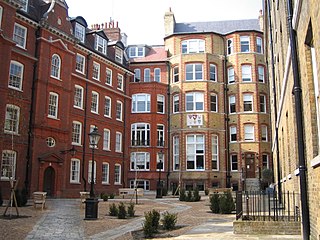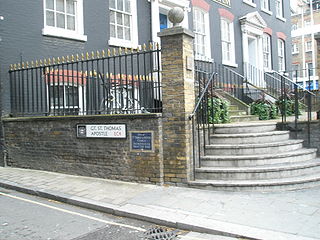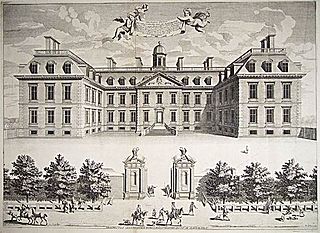
The Great Plague of London, lasting from 1665 to 1666, was the last major epidemic of the bubonic plague to occur in England. It happened within the centuries-long Second Pandemic, a period of intermittent bubonic plague epidemics that originated in Central Asia in 1331, included related diseases such as pneumonic plague and septicemic plague, which lasted until 1750.

Sir Christopher Wren PRS FRS was one of the most highly acclaimed English architects in history, as well as an anatomist, astronomer, geometer, and mathematician-physicist. He was accorded responsibility for rebuilding 52 churches in the City of London after the Great Fire in 1666, including what is regarded as his masterpiece, St Paul's Cathedral, on Ludgate Hill, completed in 1710.

The Honourable Society of the Inner Temple, commonly known as the Inner Temple, is one of the four Inns of Court and is a professional associations for barristers and judges. To be called to the Bar and practise as a barrister in England and Wales, a person must belong to one of these Inns. It is located in the wider Temple area, near the Royal Courts of Justice, and within the City of London.

The Cavalier Parliament of England lasted from 8 May 1661 until 24 January 1679. It was the longest English Parliament, and longer than any Great British or UK Parliament to date, enduring for nearly 18 years of the quarter-century reign of Charles II of England. Like its predecessor, the Convention Parliament, it was overwhelmingly Royalist and is also known as the Pensioner Parliament for the many pensions it granted to adherents of the King.

The Monument to the Great Fire of London, more commonly known simply as the Monument, is a fluted Doric column in London, England, situated near the northern end of London Bridge. Commemorating the Great Fire of London, it stands at the junction of Monument Street and Fish Street Hill, 202 feet (62 m) in height and 202 feet west of the spot in Pudding Lane where the Great Fire started on 2 September 1666. Constructed between 1671 and 1677, it was built on the site of St Margaret, New Fish Street, the first church to be destroyed by the Great Fire. It is Grade I-listed and is a scheduled monument. Another monument, the Golden Boy of Pye Corner, marks the point near Smithfield where the fire was stopped.

St Thomas the Apostle was a parish church in St Thomas Apostle Street in the City of London. In existence by the late twelfth century, it was destroyed in the Great Fire of London in 1666 and not rebuilt.

Annus Mirabilis is a poem written by John Dryden published in 1667. It commemorated 1665–1666, the "year of miracles" of London. Despite the poem's name, the year had been one of great tragedy, including the Great Fire of London. The title was perhaps meant to suggest that the events of the year could have been worse. Dryden wrote the poem while at Charlton in Wiltshire, where he went to escape one of the great events of the year: the Great Plague of London.

Sir Roger Pratt was an English gentleman-architect of the 17th century. He designed only five known buildings, but was highly influential, establishing a particularly English type of house, which was widely imitated. He drew on a range of European influences, and also on the work of Inigo Jones, England's first classical architect. Pratt also served on official commissions, and in 1668 was the first English architect to be knighted for his services.
Sir Thomas Bloodworth, born Blidward, also spelled Bludworth was an English merchant and politician who sat in the House of Commons from 1660 to 1679. He was Lord Mayor of London from October 1665 to October 1666 and his inaction during the early stages of the Great Fire of London was widely criticised as one of the causes for the great extent of the damage to the city.

Hugh May was an English architect in the period after the Restoration of King Charles II. He worked in the era which fell between the first introduction of Palladianism into England by Inigo Jones, and the full flowering of English Baroque under John Vanbrugh and Nicholas Hawksmoor. His own work was influenced by both Jones' work, and by Dutch architecture. Although May's only surviving works are Eltham Lodge, and the east front, stables and chapel at Cornbury House, his designs were influential. Together with his contemporary, Sir Roger Pratt, May was responsible for introducing and popularising an Anglo-Dutch type of house, which was widely imitated.

St Peter upon Cornhill is an Anglican church on the corner of Cornhill and Gracechurch Street in the City of London of medieval, or possibly Roman origin. It was destroyed in the Great Fire of London in 1666 and rebuilt to the designs of Sir Christopher Wren. It is now a satellite church in the parish of St Helen's Bishopsgate. It lies in the ward of Cornhill.
Sir William Cockayne (Cokayne) was a seventeenth-century merchant, alderman, and Lord Mayor of the City of London.

The Great Fire of London was a major conflagration that swept through the central parts of London from Sunday, 2 September to Thursday, 6 September 1666. The fire gutted the medieval City of London inside the old Roman city wall. The death toll is generally thought to have been relatively small, although some historians have challenged this belief.

Old St Paul's Cathedral was the cathedral of the City of London that, until the Great Fire of 1666, stood on the site of the present St Paul's Cathedral. Built from 1087 to 1314 and dedicated to Saint Paul, the cathedral was perhaps the fourth church at Ludgate Hill.
The Rebuilding of London Act 1666 is an Act of the Parliament of England with the long title "An Act for rebuilding the City of London." The Act was passed in February 1667 in the aftermath of the Great Fire of London and drawn up by Sir Matthew Hale. An earlier Act, the Fire of London Disputes Act 1666, had set up a court to settle disputes arising from buildings destroyed by the Fire. This Act regulated the rebuilding, authorized the City of London Corporation to reopen and widen roads, designated the anniversary of the Fire a feast day, and authorized the building of the Monument. A duty of one shilling on a chaldron of coal was imposed to pay for these measures.
Events from the year 1667 in England. Dates are given in Old Style. As of the start of this year, the Gregorian calendar in use by the Dutch Republic and elsewhere on the continent is 10 days ahead of the Julian calendar in use in England.

Sir Wadham Wyndham, of Ilton, Somerset and St. Edmund’s College, Salisbury, was a Justice of the King's Bench from 1660 to 1668.
This article covers the history of London during the Stuart period from 1603 to 1714.

St Gabriel Fenchurch was a parish church in the Langbourn Ward of the City of London, destroyed in the Great Fire of London and not rebuilt.

The Grand Model was a utopian plan for the Province of Carolina, founded in 1670. It consisted of a constitution coupled with a settlement and development plan for the colony. The former was titled the Fundamental Constitutions of Carolina. The word "constitutions" was synonymous with "articles." The document was composed of 120 constitutions, or articles. The settlement and development plan for the colony consisted of several documents, or "instructions," for guiding town and regional planning as well as economic development.














